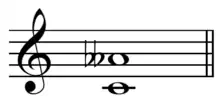| Inverse | augmented third |
|---|---|
| Name | |
| Other names | - |
| Abbreviation | d6[1] |
| Size | |
| Semitones | 7 |
| Interval class | 5 |
| Just interval | 192:125,[2] 32:21,49:32 |
| Cents | |
| 12-Tone equal temperament | 700 |
| 24-Tone equal temperament | 700 |
| Just intonation | 743 |

In classical music from Western culture, a diminished sixth (ⓘ) is an interval produced by narrowing a minor sixth by a chromatic semitone.[1][3] For example, the interval from A to F is a minor sixth, eight semitones wide, and both the intervals from A♯ to F, and from A to F♭ are diminished sixths, spanning seven semitones. Being diminished, it is considered a dissonant interval,[4] despite being equivalent to an interval known for its consonance.
Its inversion is the augmented third, and its enharmonic equivalent is the perfect fifth.
"Wolf fifth"
A severely dissonant diminished sixth is observed when the instrument is tuned using a Pythagorean or a meantone temperament tuning system. Typically, this is the interval between G♯ and E♭. Since it seems to "howl like a wolf" (because of the beating), and since it is meant to be the enharmonic equivalent to a fifth, this interval is called the "wolf" fifth. Notice that a justly tuned fifth is the most consonant interval after the perfect unison and the perfect octave.
References
- 1 2 Benward & Saker (2003). Music: In Theory and Practice, Vol. I, p.54. ISBN 978-0-07-294262-0. Specific example of an d6 not given but general example of minor intervals described.
- ↑ Haluska, Jan (2003). The Mathematical Theory of Tone Systems, p.xxvi. ISBN 0-8247-4714-3. Classic diminished sixth.
- ↑ Hoffmann, F.A. (1881). Music: Its Theory & Practice, p.89-90. Thurgate & Sons. Digitized Aug 16, 2007.
- ↑ Benward & Saker (2003), p.92.